2022 KIA NIRO HYBRID EV roof rack
[x] Cancel search: roof rackPage 61 of 684
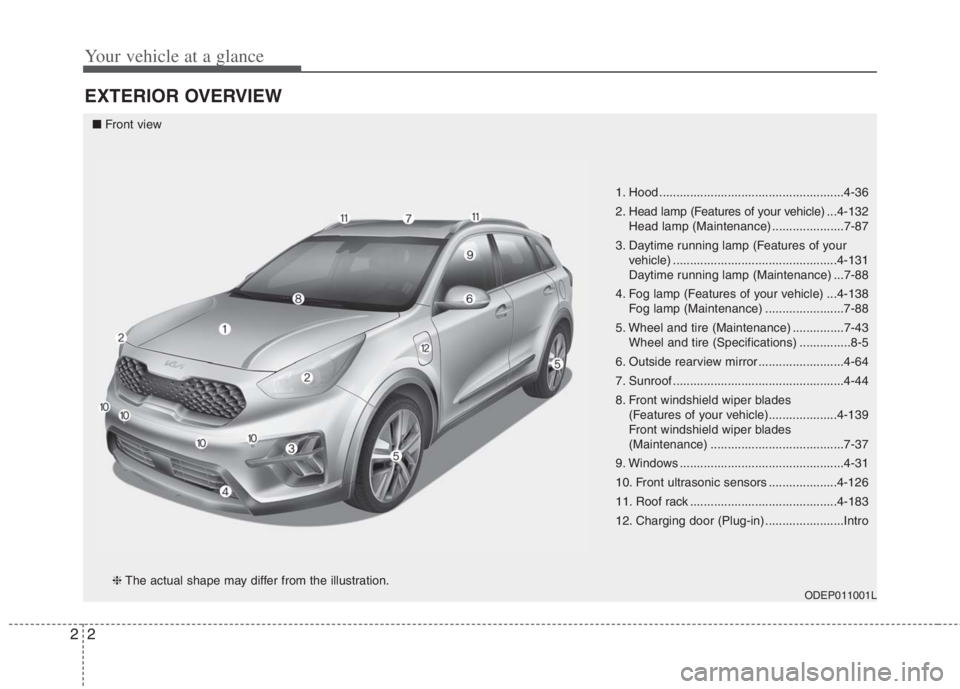
Your vehicle at a glance
2 2
EXTERIOR OVERVIEW
1. Hood ......................................................4-36
2. Head lamp (Features of your vehicle) ...4-132
Head lamp (Maintenance) .....................7-87
3. Daytime running lamp (Features of your
vehicle) ................................................4-131
Daytime running lamp (Maintenance) ...7-88
4. Fog lamp (Features of your vehicle) ...4-138
Fog lamp (Maintenance) .......................7-88
5. Wheel and tire (Maintenance) ...............7-43
Wheel and tire (Specifications) ...............8-5
6. Outside rearview mirror .........................4-64
7. Sunroof ..................................................4-44
8. Front windshield wiper blades
(Features of your vehicle)....................4-139
Front windshield wiper blades
(Maintenance) .......................................7-37
9. Windows ................................................4-31
10. Front ultrasonic sensors ....................4-126
11. Roof rack ...........................................4-183
12. Charging door (Plug-in) .......................Intro
ODEP011001L
■Front view
❈The actual shape may differ from the illustration.
Page 321 of 684
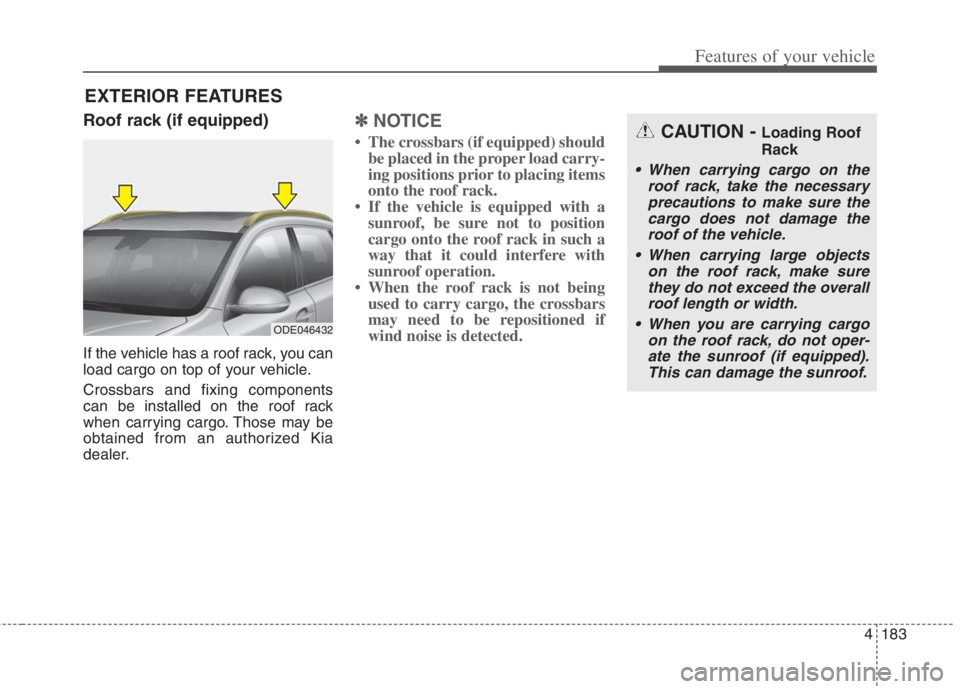
4183
Features of your vehicle
Roof rack (if equipped)
If the vehicle has a roof rack, you can
load cargo on top of your vehicle.
Crossbars and fixing components
can be installed on the roof rack
when carrying cargo. Those may be
obtained from an authorized Kia
dealer.
✽ ✽
NOTICE
• The crossbars (if equipped) should
be placed in the proper load carry-
ing positions prior to placing items
onto the roof rack.
• If the vehicle is equipped with a
sunroof, be sure not to position
cargo onto the roof rack in such a
way that it could interfere with
sunroof operation.
• When the roof rack is not being
used to carry cargo, the crossbars
may need to be repositioned if
wind noise is detected.
EXTERIOR FEATURES
CAUTION - Loading Roof
Rack
When carrying cargo on the
roof rack, take the necessary
precautions to make sure the
cargo does not damage the
roof of the vehicle.
When carrying large objects
on the roof rack, make sure
they do not exceed the overall
roof length or width.
When you are carrying cargo
on the roof rack, do not oper-
ate the sunroof (if equipped).
This can damage the sunroof.
ODE046432
Page 322 of 684
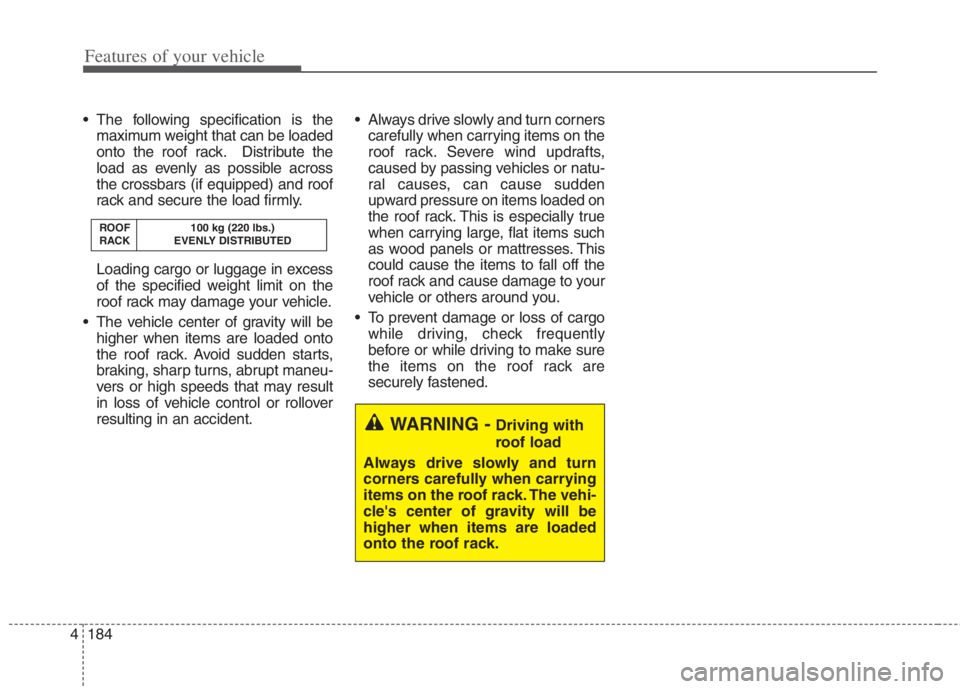
Features of your vehicle
184 4
The following specification is the
maximum weight that can be loaded
onto the roof rack. Distribute the
load as evenly as possible across
the crossbars (if equipped) and roof
rack and secure the load firmly.
Loading cargo or luggage in excess
of the specified weight limit on the
roof rack may damage your vehicle.
The vehicle center of gravity will be
higher when items are loaded onto
the roof rack. Avoid sudden starts,
braking, sharp turns, abrupt maneu-
vers or high speeds that may result
in loss of vehicle control or rollover
resulting in an accident. Always drive slowly and turn corners
carefully when carrying items on the
roof rack. Severe wind updrafts,
caused by passing vehicles or natu-
ral causes, can cause sudden
upward pressure on items loaded on
the roof rack. This is especially true
when carrying large, flat items such
as wood panels or mattresses. This
could cause the items to fall off the
roof rack and cause damage to your
vehicle or others around you.
To prevent damage or loss of cargo
while driving, check frequently
before or while driving to make sure
the items on the roof rack are
securely fastened.
ROOF 100 kg (220 lbs.)
RACK EVENLY DISTRIBUTED
WARNING -Driving with
roof load
Always drive slowly and turn
corners carefully when carrying
items on the roof rack. The vehi-
cle's center of gravity will be
higher when items are loaded
onto the roof rack.
Page 487 of 684
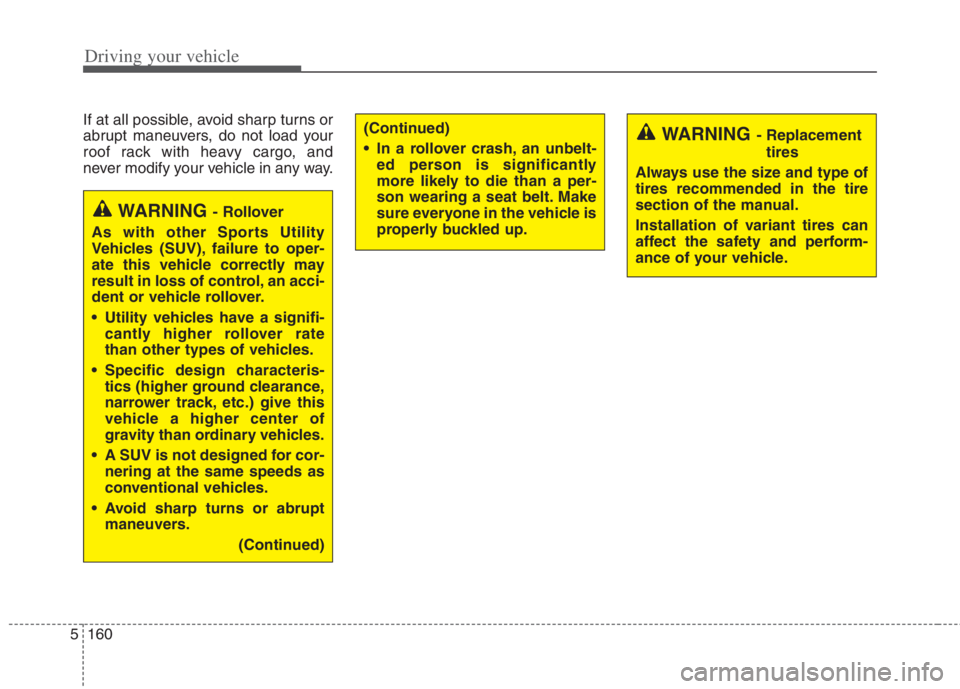
Driving your vehicle
160
5
If at all possible, avoid sharp turns or
abrupt maneuvers, do not load your
roof rack with heavy cargo, and
never modify your vehicle in any way.
WARNING - Replacement
tires
Always use the size and type of
tires recommended in the tire
section of the manual.
Installation of variant tires can
affect the safety and perform-
ance of your vehicle.
WARNING - Rollover
As with other Sports Utility
Vehicles (SUV), failure to oper-
ate this vehicle correctly may
result in loss of control, an acci-
dent or vehicle rollover.
• Utility vehicles have a signifi- cantly higher rollover rate
than other types of vehicles.
Specific design characteris- tics (higher ground clearance,
narrower track, etc.) give this
vehicle a higher center of
gravity than ordinary vehicles.
A SUV is not designed for cor- nering at the same speeds as
conventional vehicles.
Avoid sharp turns or abrupt maneuvers.
(Continued)
(Continued)
In a rollover crash, an unbelt-ed person is significantly
more likely to die than a per-
son wearing a seat belt. Make
sure everyone in the vehicle is
properly buckled up.
Page 556 of 684
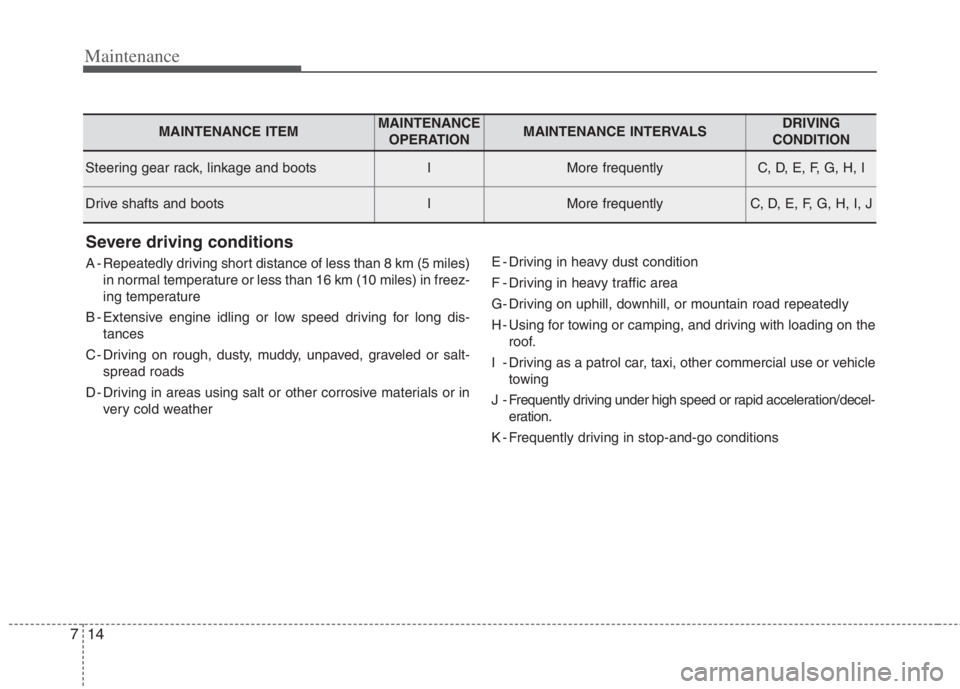
Maintenance
14 7
Severe driving conditions
A - Repeatedly driving short distance of less than 8 km (5 miles)
in normal temperature or less than 16 km (10 miles) in freez-
ing temperature
B - Extensive engine idling or low speed driving for long dis-
tances
C - Driving on rough, dusty, muddy, unpaved, graveled or salt-
spread roads
D - Driving in areas using salt or other corrosive materials or in
very cold weatherE - Driving in heavy dust condition
F - Driving in heavy traffic area
G- Driving on uphill, downhill, or mountain road repeatedly
H - Using for towing or camping, and driving with loading on the
roof.
I - Driving as a patrol car, taxi, other commercial use or vehicle
towing
J - Frequently driving under high speed or rapid acceleration/decel-
eration.
K - Frequently driving in stop-and-go conditions
MAINTENANCE ITEMMAINTENANCE
OPERATIONMAINTENANCE INTERVALSDRIVING
CONDITION
Steering gear rack, linkage and bootsIMore frequentlyC, D, E, F, G, H, I
Drive shafts and bootsIMore frequentlyC, D, E, F, G, H, I, J
Page 596 of 684
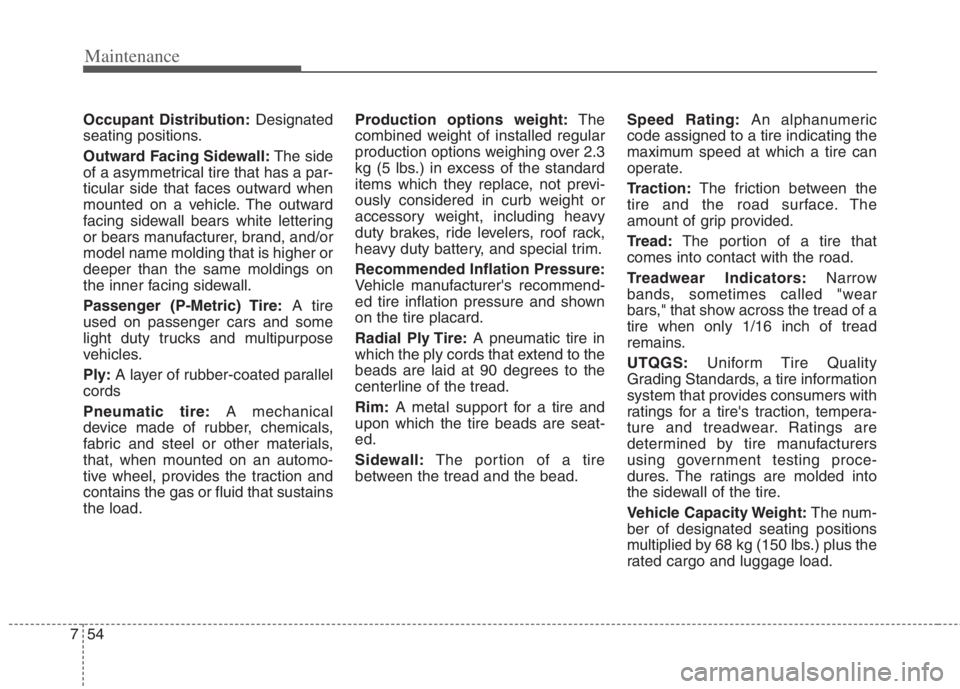
Maintenance
54 7
Occupant Distribution:Designated
seating positions.
Outward Facing Sidewall:The side
of a asymmetrical tire that has a par-
ticular side that faces outward when
mounted on a vehicle. The outward
facing sidewall bears white lettering
or bears manufacturer, brand, and/or
model name molding that is higher or
deeper than the same moldings on
the inner facing sidewall.
Passenger (P-Metric) Tire:A tire
used on passenger cars and some
light duty trucks and multipurpose
vehicles.
Ply:A layer of rubber-coated parallel
cords
Pneumatic tire:A mechanical
device made of rubber, chemicals,
fabric and steel or other materials,
that, when mounted on an automo-
tive wheel, provides the traction and
contains the gas or fluid that sustains
the load.Production options weight:The
combined weight of installed regular
production options weighing over 2.3
kg (5 lbs.) in excess of the standard
items which they replace, not previ-
ously considered in curb weight or
accessory weight, including heavy
duty brakes, ride levelers, roof rack,
heavy duty battery, and special trim.
Recommended Inflation Pressure:
Vehicle manufacturer's recommend-
ed tire inflation pressure and shown
on the tire placard.
Radial Ply Tire:A pneumatic tire in
which the ply cords that extend to the
beads are laid at 90 degrees to the
centerline of the tread.
Rim:A metal support for a tire and
upon which the tire beads are seat-
ed.
Sidewall:The portion of a tire
between the tread and the bead.Speed Rating:An alphanumeric
code assigned to a tire indicating the
maximum speed at which a tire can
operate.
Traction:The friction between the
tire and the road surface. The
amount of grip provided.
Tread:The portion of a tire that
comes into contact with the road.
Treadwear Indicators:Narrow
bands, sometimes called "wear
bars," that show across the tread of a
tire when only 1/16 inch of tread
remains.
UTQGS:Uniform Tire Quality
Grading Standards, a tire information
system that provides consumers with
ratings for a tire's traction, tempera-
ture and treadwear. Ratings are
determined by tire manufacturers
using government testing proce-
dures. The ratings are molded into
the sidewall of the tire.
Vehicle Capacity Weight:The num-
ber of designated seating positions
multiplied by 68 kg (150 lbs.) plus the
rated cargo and luggage load.
Page 662 of 684
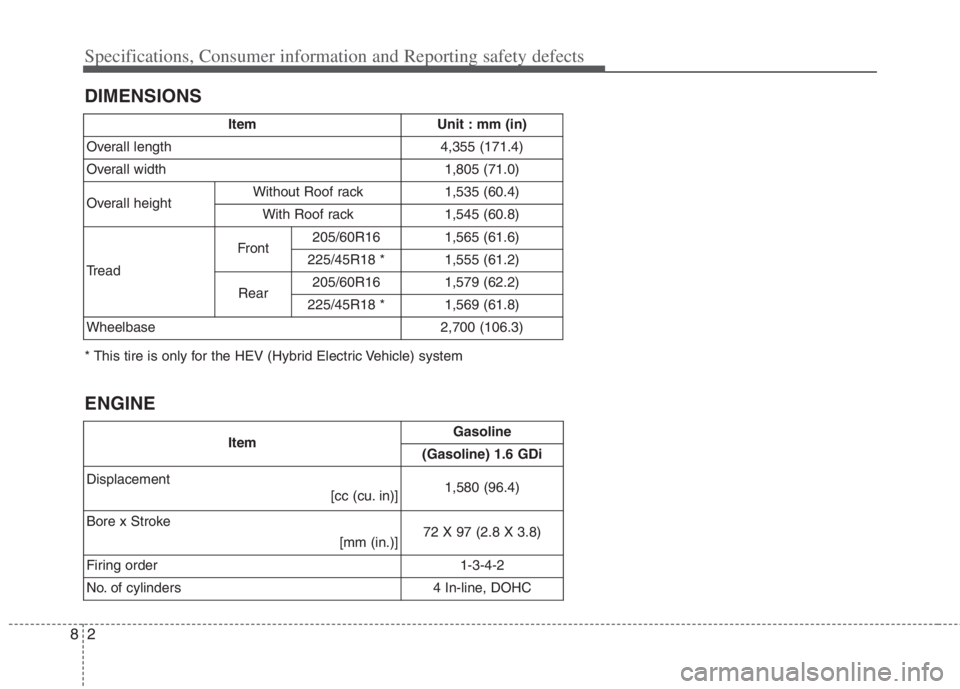
2 8
DIMENSIONS Specifications, Consumer information and Reporting safety defects
ENGINE
ItemUnit : mm (in)
Overall length4,355 (171.4)
Overall width1,805 (71.0)
Overall heightWithout Roof rack1,535 (60.4)
With Roof rack1,545 (60.8)
Tread
Front205/60R161,565 (61.6)
225/45R18 *1,555 (61.2)
Rear205/60R161,579 (62.2)
225/45R18 *1,569 (61.8)
Wheelbase2,700 (106.3)
ItemGasoline
(Gasoline) 1.6 GDi
Displacement
[cc (cu. in)]
1,580 (96.4)
Bore x Stroke
[mm (in.)]
72 X 97 (2.8 X 3.8)
Firing order
1-3-4-2
No. of cylinders
4 In-line, DOHC
* This tire is only for the HEV (Hybrid Electric Vehicle) system
Page 677 of 684
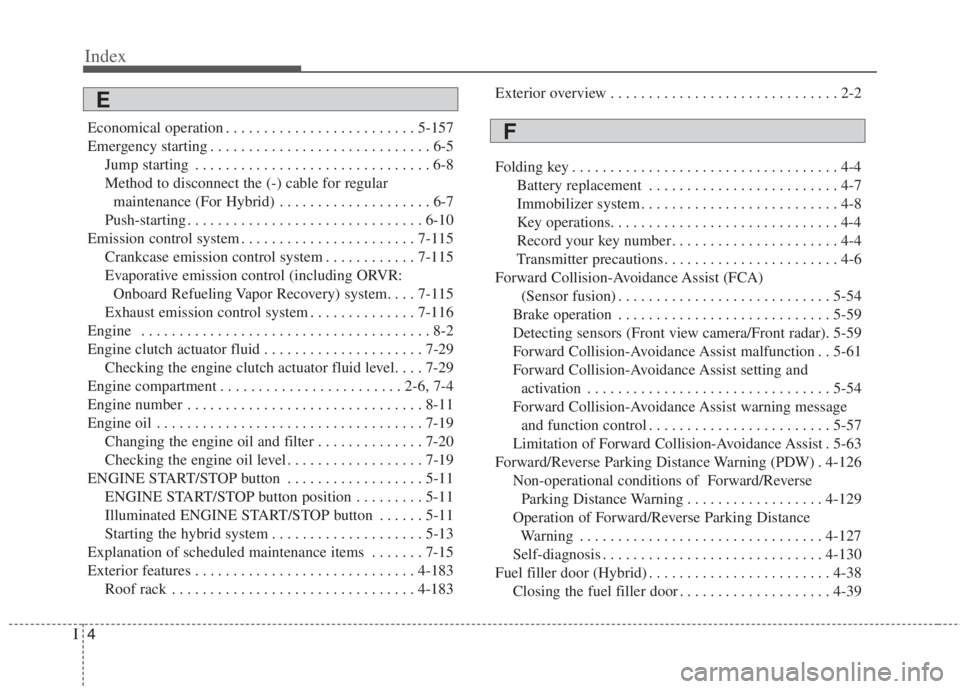
Index
4I
Economical operation . . . . . . . . . . . . . . . . . . . . . . . . . 5-157
Emergency starting . . . . . . . . . . . . . . . . . . . . . . . . . . . . . 6-5
Jump starting . . . . . . . . . . . . . . . . . . . . . . . . . . . . . . . 6-8
Method to disconnect the (-) cable for regular
maintenance (For Hybrid) . . . . . . . . . . . . . . . . . . . . 6-7
Push-starting . . . . . . . . . . . . . . . . . . . . . . . . . . . . . . . 6-10
Emission control system . . . . . . . . . . . . . . . . . . . . . . . 7-115
Crankcase emission control system . . . . . . . . . . . . 7-115
Evaporative emission control (including ORVR:
Onboard Refueling Vapor Recovery) system. . . . 7-115
Exhaust emission control system . . . . . . . . . . . . . . 7-116
Engine . . . . . . . . . . . . . . . . . . . . . . . . . . . . . . . . . . . . . . 8-2
Engine clutch actuator fluid . . . . . . . . . . . . . . . . . . . . . 7-29
Checking the engine clutch actuator fluid level. . . . 7-29
Engine compartment . . . . . . . . . . . . . . . . . . . . . . . . 2-6, 7-4
Engine number . . . . . . . . . . . . . . . . . . . . . . . . . . . . . . . 8-11
Engine oil . . . . . . . . . . . . . . . . . . . . . . . . . . . . . . . . . . . 7-19
Changing the engine oil and filter . . . . . . . . . . . . . . 7-20
Checking the engine oil level . . . . . . . . . . . . . . . . . . 7-19
ENGINE START/STOP button . . . . . . . . . . . . . . . . . . 5-11
ENGINE START/STOP button position . . . . . . . . . 5-11
Illuminated ENGINE START/STOP button . . . . . . 5-11
Starting the hybrid system . . . . . . . . . . . . . . . . . . . . 5-13
Explanation of scheduled maintenance items . . . . . . . 7-15
Exterior features . . . . . . . . . . . . . . . . . . . . . . . . . . . . . 4-183
Roof rack . . . . . . . . . . . . . . . . . . . . . . . . . . . . . . . . 4-183Exterior overview . . . . . . . . . . . . . . . . . . . . . . . . . . . . . . 2-2
Folding key . . . . . . . . . . . . . . . . . . . . . . . . . . . . . . . . . . . 4-4
Battery replacement . . . . . . . . . . . . . . . . . . . . . . . . . 4-7
Immobilizer system . . . . . . . . . . . . . . . . . . . . . . . . . . 4-8
Key operations. . . . . . . . . . . . . . . . . . . . . . . . . . . . . . 4-4
Record your key number . . . . . . . . . . . . . . . . . . . . . . 4-4
Transmitter precautions . . . . . . . . . . . . . . . . . . . . . . . 4-6
Forward Collision-Avoidance Assist (FCA)
(Sensor fusion) . . . . . . . . . . . . . . . . . . . . . . . . . . . . 5-54
Brake operation . . . . . . . . . . . . . . . . . . . . . . . . . . . . 5-59
Detecting sensors (Front view camera/Front radar). 5-59
Forward Collision-Avoidance Assist malfunction . . 5-61
Forward Collision-Avoidance Assist setting and
activation . . . . . . . . . . . . . . . . . . . . . . . . . . . . . . . . 5-54
Forward Collision-Avoidance Assist warning message
and function control . . . . . . . . . . . . . . . . . . . . . . . . 5-57
Limitation of Forward Collision-Avoidance Assist . 5-63
Forward/Reverse Parking Distance Warning (PDW) . 4-126
Non-operational conditions of Forward/Reverse
Parking Distance Warning . . . . . . . . . . . . . . . . . . 4-129
Operation of Forward/Reverse Parking Distance
Warning . . . . . . . . . . . . . . . . . . . . . . . . . . . . . . . . 4-127
Self-diagnosis . . . . . . . . . . . . . . . . . . . . . . . . . . . . . 4-130
Fuel filler door (Hybrid) . . . . . . . . . . . . . . . . . . . . . . . . 4-38
Closing the fuel filler door . . . . . . . . . . . . . . . . . . . . 4-39F
E